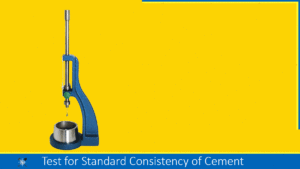Have you ever thought about the potential for enhancing the appearance of your home through the use of appropriate paint? Have you made a decision regarding selecting the proper paint to protect your home from premature ageing? In this guide, you will learn when, what, and how to apply paint, as well as receive guidance on selecting the most suitable types of paint. Continue reading for more information.
Types of Paints Used in Building Construction
All most every part of the buildings need to be protected against the natural elements. Therefore, it is done by applying the paints. Paint applied in the building are internal and external walls, timber and steel works, exposed concrete surfaces (such as slabs, beams, columns, stairs, etc.) and roof covering. The paint applied to internal walls is Distemper and Plastic emulsion. Exterior walls are applied with cement paint and acrylic emulsion.
Aluminium Paints
It consists of a very finely ground aluminium powder that has been washed with an oil varnish. It has excellent covering capacity and protects the steel from corrosion of salts and acid gases. It resists heat. It does not oxidize and does not fade. The surface will look better. Aluminium paint is visible in the dark and does not allow moisture to pass through. Therefore, it has high reflectance and high electrical resistance.
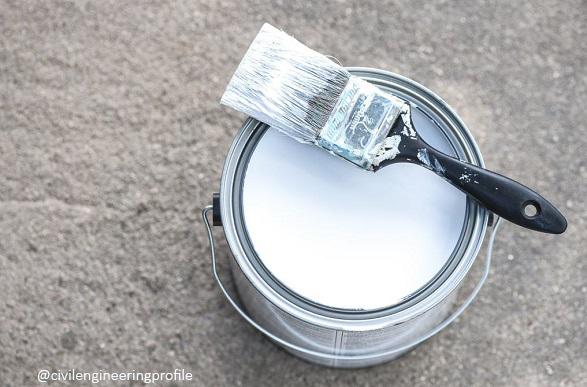
The aluminium paint is unique and its flakes float on the painted surface, forming an opaque metal coating that reflects heat and light. One litre of aluminium paint is sufficient for an area of 20 square meters. The paint hardens within 6-8 hours and dries completely within 12-18 hours. When the paint is stored for a long period of time, it becomes more viscous and stain particles appear on the paint. Before using, add thinner and let the cloth pass.
This is a traditional industrial paint and is widely used for painting radiators, hot water pipes, gas tanks, grills, utility poles, oil tanks, etc.
Also, read: Aluminium Paint: Enhancing Protection And Aesthetics
Enamel Paints
Enamels consist of high-grade bases like zinc or lead oxide ground in oil or varnish. They dry slowly leaving a hard, tough, and elastic film which is smooth and durable. Enamel-painted surfaces are washable. The surface provided with this paint is not affected by acids, alkalis, grease, or steam even during hot and cold weather. These can be made in any tint, however delicate. Even though they are more costly than ordinary paints, because of their durability, they ultimately prove to be more economical.
They are equally good for both external and internal work. Enamel made from synthetic resins, known as synthetic enamel, dries quickly and is more durable as it forms a tough, elastic, and glossy film. Enamel paints are used for painting doors, windows, and all wood-based products. To improve the appearance, it is better to apply a coat of titanium white in pale linseed oil before the coat of enamel paint.
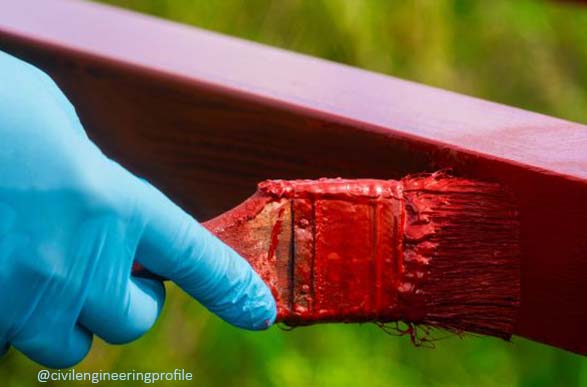
Emulsion Paints
There are two types of emulsion paints available; one is an ordinary emulsion and the other is a plastic emulsion. In plastic emulsion paints, vinyl or acrylic resins are added. The resin consists of latex similar to rubber. It is insoluble in water which is present to the extent of about 30%. Latex is polyvinyl acetate and the pigments might be titanium dioxide. The emulsifiers are incompatible with resins which results in low-gloss paints. The paint pigments have some of the advantages of soil-based coatings, the ability to bind back loose power on the substrate, and more penetration adhesion.
Emulsion paints have fillers to thicken the film, support the paint structure, and increase the volume of the emulsion paint. Emulsion paints also contain catalysts, stabilizers, emulsifiers, adhesion enhancers, texturizers, and flatteners. Once the paint is applied, the emulsion paint becomes tack-free on solidifying. Hardening of the paint may result because of curing, evaporation, or even phase change, depending on the type of binder.
Emulsion paints also contain a lot of additives to impart various properties like antifreeze, foam control, skinning control, bacterial growth control, and pigment stability. Butadiene-Styrene is a commonly used resin for making emulsion which produces a fire-resistant odourless paint.
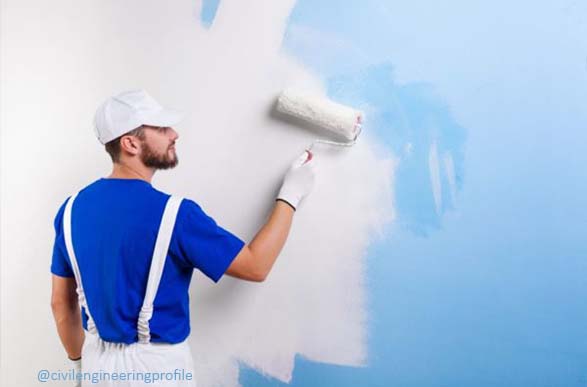
The paint possesses excellent alkali resistance. The paint is easy to apply and dries quickly within 1 1/2 to 2 hours. The colour is retained for a longer period. The painted surface can be washed with water. It is applied on brick and masonry surfaces which contain free alkalis. For long service life, it is better to apply two coats of emulsion paint.
Oil Paint
Oil paint has a white base and it is applied in three coats a primer, an under layer and a finish coat. This paint is available in two finishes namely matte and glossy. Oil paint is a popular choice since it is long-lasting and inexpensive. It is simple to apply and gives a clean finish. This paint is often applied on walls, doors, windows, and metal surfaces. This type of paint does not work well in humid environments and takes longer to cure.
Plastic paint
Plastic paint is available in the market under different tread names and in attractive colours. The plastic emulsion paint is made up of plastic compounds such as vinyl acetate and acrylate which are held in water. One litre of plastic emulsion paint has a coverage of about 15 m2. The paint cannot withstand the weather effect and saline atmosphere. It is, therefore, widely used for interior jobs. Prior to the application of paint, the surface should be cleaned of dust and levelling putty may be applied where needed. The paint is water-based, and hence, not suitable for metallic surfaces. The paint allows moisture to evaporate through minor pores but it is desirable to allow about one year for moisture to escape from fresh masonry and mortar. The drying time is six hours. The painted surface should be cleaned with a wet cloth once a month for a better appearance.
The composition of standard paint is as binder: pigment: other solids: water as 2: 5 :1: 6 and for one litre of paint, the composition is:
| Binder | 0.20kg |
| Pigment | 0.50kg |
| Other solids | 0.10kg |
| water | 0.60kg |
| Total | 1.40kg |
Bituminous Paints
This type of paint is manufactured by dissolving asphalt, tar, mineral pitches, and vegetable bitumen in any type of oil or petroleum or Naptha or white spirit. It is not considered paint but bitumen is used where a waterproof coating is required. The paint is prepared by dissolving asphalt or mineral pitches or vegetable bitumen in any type of oil or petroleum. Bitumen does not dry in the normal sense used with paint. It may crack if stressed when frozen and will run and become sticky to the touch in hot weather. It is thick and usually black.
Bitumen is used for areas where high water resistance is needed and appearance is not a consideration. Such paint is used inside cast-iron guttering and metal cold-water tanks. Bitumen is difficult to paint over conventional paints as the underlying bitumen tends to bleed into the overlaying paint. It tends to move with temperature changes while covering the paint may not be able to stand up to the movement.
If there is a need to overpaint bitumen, a coat of Aluminium paint may be applied which will seal the surface to prevent the bitumen from bleeding.
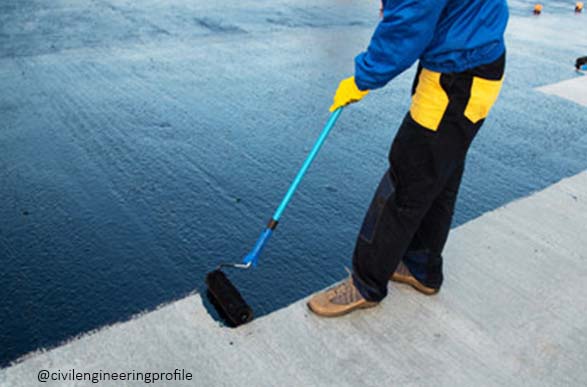
Cement Paint
The constituents of cement paint are white cement, pigment, accelerator, and other additives. The pigment contains varying proportions of hydrated lime, hygroscopic salts, and water-repellent additives like Aluminium stearates. This paint is available in a variety of shades and exhibits an excellent decorative appearance. It is resistant to fungus and algae. It protects the building from varying weather conditions.
Cement paint can be applied on both internal and external surfaces of buildings. The paint is suitable for use on bricks, stones, and concrete but not on metals and timber. The paint can be applied on new, old, and damp walls, even on freshly plastered walls. It is waterproof and durable.
Cement paint is applied in two coats. The second coat is applied not before 24 hours of the first coat. Curing is done soon after the surface has dried and continued for 2 to 3 days after each application.
Cement paint is not used on surfaces already with whitewash, colour wash, and dry distemper without scraping and cleaning properly. The paint is not applied in rain or when the temperature falls below 5⁰ C.
Luminous Paint
Such types of paints are for special purposes and, hence, very costly. The paint may either be phosphorescent or fluorescent. The former absorbs light and glows for an appreciable period after the exciting light source has been extinguished. But the latter emits some light only during activation by ultraviolet light. The medium may be oil or cellulose varnish. Owing to their coarseness, phosphorescent paints have poor gloss, do not flow well and tend to settle hard quickly. Satisfactory results are obtained if they are applied over a base coat of zinc white. On one account should the undercoat contain white lead either as pigment or direr? The paint should be applied on a surface free from corrosion.
These paints are used for painting symbols on roads and highways. They are quite helpful during the night.
| Compounds | Luminosity | Colour |
|---|---|---|
| Zinc Sulphide or Zinc and Cadmium Sulphide | Relatively bright | Greenish Yellow |
| Calcium Sulphide, Strontium Sulphide, or a combination of two | Less bright | Bluish Green at night and dull white during the day |
Silicate Paint
This is paint manufactured by mixing calcined and finely ground silica with resinous substances. Silica imparts good adhesion to the paint. It can withstand extreme heat. It is not affected by alkalis. No chemical action is found on metals. It also adheres firmly to brickwork. On drying, the paint forms a hard surface and is durable. Before the application of paint, the surface should be made wet. Two to three coats of paint are generally applied but the surface is not painted with this paint in hot weather.
This type of paint is used in boilers, ovens, and on concrete and masonry surfaces. The paint is also resistant to ultraviolet radiation.
Cellulose Paint
This paint is a product from nitro-cotton, celluloid sheets, and photographic films. While oil paint hardens by oxidation, cellulose paint hardens by evaporation of the thinning agents. It hardens quickly and presents a smooth surface. Compared to ordinary oil paints, this paint can be washed and cleaned easily as it has greater hardness and elasticity. The paint remains unaffected by hot water and the surface can withstand extreme heat and cold. For this reason, the paint is used for painting motor cars and aeroplanes.
Also, read: Bhutanese Painting for Building Construction in Bhutan.
FAQs:
Q: Which paint is applied for the external walls?
A: Exterior paint is designed to withstand harsh weather conditions, resist fading and cracking, and provide protection against moisture and mildew growth. Generally, acrylic-based paints are a popular choice for exterior walls as they provide good adhesion and durability, and are resistant to fading.
Q: What is acrylic distemper paint?
A: Acrylic distemper is a water-based paint that is commonly used for interior walls. It is made by mixing acrylic resin with pigment, filler, and water. Unlike traditional distemper paint, which is made from chalk and glue, acrylic distemper is more durable, has better adhesion, and is resistant to chalking and flaking.
Q: What is acrylic enamel paint?
A: Acrylic enamel paint is a water-based paint that contains acrylic resin and enamel. It is a durable and high-performance paint that provides a glossy finish and is resistant to scratches and chipping. It is commonly used for painting metal, wood, and plastic surfaces, and is suitable for both interior and exterior applications.
Q: What are the advantages of synthetic enamel paints?
A: Synthetic enamel paints, also known as alkyd enamel paint, is a type of oil-based paint that contains a synthetic resin as a binder. It has several advantages as follows:
Durability: Synthetic enamel paint is highly durable and provides excellent protection against wear and tear. It is resistant to chipping, fading, and scratches, making it ideal for use in high-traffic areas.
Glossy finish: Synthetic enamel paint provides a glossy and lustrous finish that enhances the visual appeal of surfaces. It is commonly used for painting furniture, cabinets, doors, and trim work.
Weather resistance: Synthetic enamel paint is highly resistant to weather and environmental conditions. It can withstand exposure to sunlight, rain, and humidity without losing its shine or colour.
Easy to clean: Synthetic enamel paint is easy to clean and maintain. It can be wiped clean with a damp cloth, and stains and marks can be easily removed without damaging the surface.
Long-lasting colour: Synthetic enamel paint retains its colour for a long time without fading or yellowing. It provides a vibrant and attractive finish that lasts for years.
![]()







